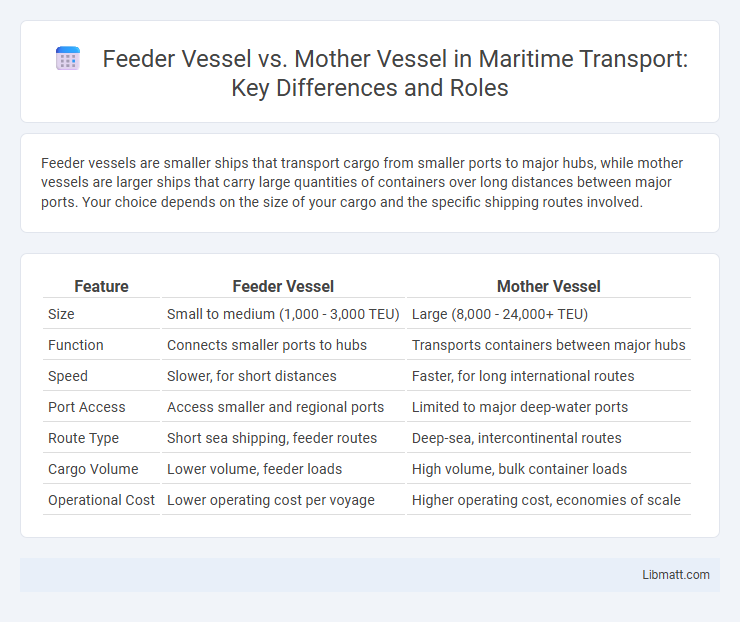Feeder vessels are smaller ships that transport cargo from smaller ports to major hubs, while mother vessels are larger ships that carry large quantities of containers over long distances between major ports. Your choice depends on the size of your cargo and the specific shipping routes involved.
Table of Comparison
| Feature | Feeder Vessel | Mother Vessel |
|---|---|---|
| Size | Small to medium (1,000 - 3,000 TEU) | Large (8,000 - 24,000+ TEU) |
| Function | Connects smaller ports to hubs | Transports containers between major hubs |
| Speed | Slower, for short distances | Faster, for long international routes |
| Port Access | Access smaller and regional ports | Limited to major deep-water ports |
| Route Type | Short sea shipping, feeder routes | Deep-sea, intercontinental routes |
| Cargo Volume | Lower volume, feeder loads | High volume, bulk container loads |
| Operational Cost | Lower operating cost per voyage | Higher operating cost, economies of scale |
Introduction to Feeder and Mother Vessels
Feeder vessels are smaller ships designed to transport containers between regional ports and larger hub ports, facilitating efficient cargo transfer within short distances. Mother vessels, also known as main vessels, are substantially larger ships that carry significant container loads across major oceanic trade routes, serving as the backbone of global shipping networks. Understanding the distinct roles of feeder and mother vessels helps optimize your logistics strategy by balancing speed, capacity, and network connectivity in container shipping.
Definition of Feeder Vessels
Feeder vessels are small to medium-sized ships designed to transport containers and cargo between smaller ports and larger hub ports, where the cargo is then transferred to mother vessels for long-haul shipping. They operate within regional or short-sea routes, effectively connecting local markets to global shipping networks. Feeder vessels optimize logistics by enabling more frequent service and access to ports that cannot accommodate large mother vessels.
Definition of Mother Vessels
Mother vessels are large container ships designed to transport vast quantities of cargo between major ports, serving as the main carriers in global shipping networks. These vessels are capable of carrying thousands of TEUs (twenty-foot equivalent units) and operate on long-haul routes, connecting key transshipment hubs. Unlike feeder vessels, mother vessels do not typically access smaller ports directly, relying on feeder ships to transfer containers to and from regional locations.
Key Differences Between Feeder and Mother Vessels
Feeder vessels are smaller ships designed to transport containers between smaller ports and central hub ports, facilitating regional distribution. Mother vessels are large container ships that operate on main shipping lanes, carrying huge cargo volumes across long distances from hub ports. The key differences lie in their size, operational range, and function: feeder vessels support regional feeder services, while mother vessels handle long-haul, high-capacity ocean transport.
Advantages of Feeder Vessels
Feeder vessels offer greater flexibility and access to smaller ports that larger mother vessels cannot reach, optimizing your shipping routes and reducing turnaround times. They enable cost-effective regional distribution by consolidating cargo from smaller harbors to major hubs, enhancing overall supply chain efficiency. Their smaller size also allows for quicker loading and unloading, improving operational speed and reliability in port logistics.
Benefits of Mother Vessels
Mother vessels offer significant benefits in large-scale maritime logistics by accommodating higher cargo volumes and enabling efficient long-haul transportation across major international routes. These vessels reduce shipping costs per container due to economies of scale and minimize port congestion by consolidating shipments before transfer to feeder vessels. Your supply chain gains enhanced reliability and faster transit times when utilizing mother vessels for global distribution hubs.
Cargo Handling and Operational Capacity
Feeder vessels specialize in transporting cargo between smaller ports and larger hub ports, offering flexible and frequent service with limited cargo handling capacity, typically up to a few thousand TEUs. Mother vessels, or mainline vessels, operate on primary trade routes with significantly higher operational capacity, often exceeding 10,000 TEUs, enabling efficient long-haul cargo handling and bulk transport. Your choice between feeder and mother vessels depends on the scale and nature of cargo flow, optimizing logistics through appropriate vessel deployment.
Role in Global Shipping Logistics
Feeder vessels serve as smaller ships that transport containers from regional ports to larger hubs, enabling efficient consolidation and distribution within global shipping networks. Mother vessels are large container ships that carry vast quantities of cargo across major international routes, serving as the backbone of long-haul maritime freight transport. Your logistics strategy benefits from understanding the complementary roles of feeder and mother vessels in optimizing cargo movement and port connectivity.
Cost Implications and Efficiency
Feeder vessels, typically smaller in size, incur lower operating costs and provide flexible scheduling for regional ports, reducing your overall logistics expenses. Mother vessels, being larger, offer economies of scale by transporting massive cargo volumes across major hubs more efficiently, though they require significant port infrastructure and higher handling fees. Balancing the use of feeder and mother vessels optimizes shipping efficiency and cost-effectiveness across complex supply chains.
Choosing Between Feeder and Mother Vessels
Choosing between feeder vessels and mother vessels depends on cargo volume, route distance, and port infrastructure. Feeder vessels operate smaller loads over short distances, serving regional ports with limited depth or capacity, while mother vessels handle larger cargo volumes on long-haul routes between major hub ports. Effective supply chain management requires matching vessel type to shipment size and network efficiency to optimize transit times and reduce logistics costs.
Feeder vessel vs Mother vessel Infographic

 libmatt.com
libmatt.com